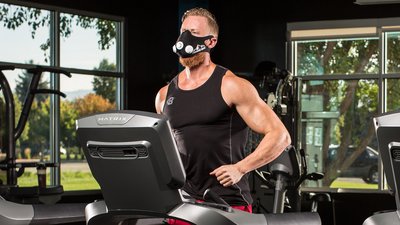He's in almost every gym. You don't know whether he's training to be a firefighter, some new breed of scuba diver, or Bane in an upcoming Batman fan film. Whatever his purpose, the masked man is working hard. After forking out close to $100 for his high-altitude training mask, this guy has to be taking his workouts to the next level, right? Unfortunately not.
Don't get me wrong: I'm all for gaining every little advantage in training. But is there actually any benefit to be gained by training with an elevation mask, which attempts to improve cardiorespiratory fitness by simulating low oxygen at a high altitude?
According to Alex Viada, a successful hybrid-training coach and founder of Complete Human Performance, such high-altitude devices "simulate altitude in the same way sticking your head in a toilet simulates swimming." Ouch.
While some users proclaim they can breathe better after using an altitude mask, I bet if I jammed a pillow down someone's throat and asked him to run a mile, he'd be able to breath much better once I took it away, too.
Damning jokes aside, the sad truth is that altitude masks simply don't simulate high altitude. In addition, some people wear them while performing anaerobic workouts like resistance training, which utilizes a completely different energy system that doesn't even require oxygen. This usage makes their value even more dubious.
Altitude Masks No Pressure
Why do elevation masks not simulate altitude? At high altitudes, the atmospheric pressure is reduced. The partial pressure of oxygen, or the total units of oxygen per given area, is also reduced. The air is simply thinner, which is why breathing at high altitudes is more difficult. Consequently, there's a reduced oxygenation of the blood, which leads to less oxygen being transported to and utilized by working muscles.
When the body is exposed to lower partial pressure at altitude (say you go from training at Venice Beach to Colorado Springs), it responds by increasing myoglobin/hemoglobin content and capillary density, and consequently increasing oxygen transport to muscles.[1,2] These adaptations could most certainly give you a performance advantage.
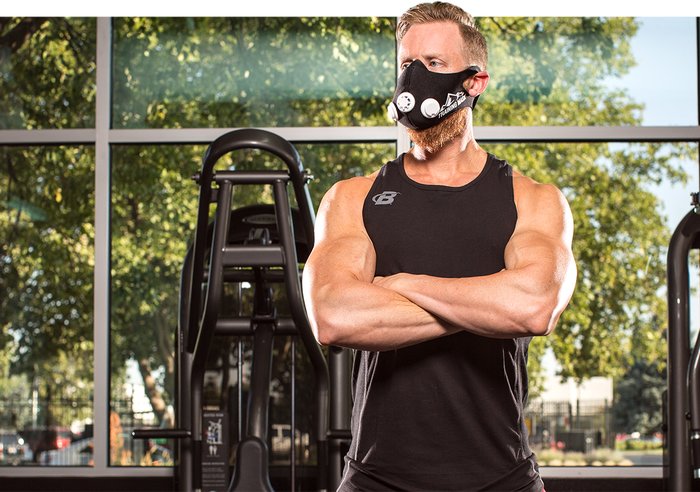
However, this process takes weeks—even months—of living and training at high altitude, not 40 minutes of rowing with a gas mask on your face at your local gym!
Moreover, until you're adapted to altitude, performance decreases. VO2 max, a measure of cardiorespiratory fitness, actually decreases by about 10 percent every 100 meters above 1100 meters.[3] Additionally, training intensity and volume are decreased, resulting in lower training quality and contributing to this reduction in overall performance.[4,5]
If you train at altitude long enough, you become adapted to the lower partial pressure. At this point, there may be some benefits to be gained for the endurance athlete, such as increased hemoglobin concentration, increased capillary density, increased mitochondrial volume and elevated buffering capacity.
The downside to training at altitude, however, is that any physiological adaptations usually fade within 3-4 weeks. Most importantly, results from studies examining training and performance adaptations from simulated hypoxic environments are mixed at best, with most showing no benefit of hypoxic training.[6,7]
Oxygen Restriction And Aerobic Training
This brings us back to the mask. The reduced partial pressure of air at altitude is much different than restricting air intake by using a mask. In fact, there's not a single person with a shred of physiology knowledge who will support elevation masks' ability to increase hemoglobin.
Elevation masks don't change the partial pressure of incoming air; all they do is simply reduce the total amount of airflow to the lungs. Imagine trying to run while breathing through a straw, or with the aforementioned pillow strapped to your face. This is essentially restricted-air training, also called "inspiratory muscle training."
Inspiratory muscle training is an incredibly effective and well-utilized tool in people with chronic obstructive pulmonary disease (COPD). It can bring about improvements in inspiratory muscle strength and endurance and exercise performance.[8,9] But in an athletic population? Not so much.
Endurance performance is not limited by the amount of air you get; it's limited by the amount of oxygen in that air, and how you use it. By training in a hypoxic environment, and not changing partial pressure as altitude would, all you're doing is improving the strength and endurance of your respiratory system.
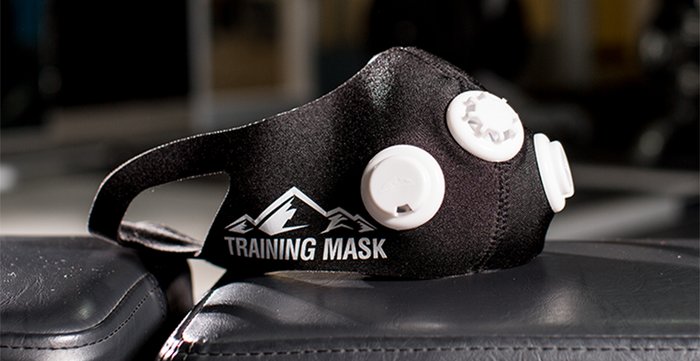
Several studies support the notion that inspiratory muscle training improves respiratory function in athletes.[10,11] The problem, however, is that inspiratory muscle training or hypoxic training does little—if anything—to improve actual exercise performance at any intensity.[11-14]
Undoubtedly, hypoxic training will feel harder than usual—your heart rate will be higher, you'll breathe harder, and you'll have a higher lactate response at submaximal exercise.[15] All of this is to be expected. By restricting oxygen, you're making your body work much harder at any given workload. However, I'd offer that the intensity and workload you could achieve without the mask would be of much higher quality and allow for more adaptation than any training you would achieve with it.
Improving your diaphragm strength and being able to exhale and inhale more forcefully, which a mask compels you to do, will do nothing for your aerobic capacity or endurance. Look at elite endurance athletes: They're incredibly metabolically efficient, and their success relies on this. A stronger diaphragm and more forceful breathing reduce this efficiency, actually impeding performance.
Whatever your training status or goals, chances are you're looking to increase your fitness level. Train to improve your VO2 max, lactate threshold, and hydrogen-ion buffering capacity. Resistance train to improve strength, power, and speed, all of which will improve endurance performance. These actions all initiate beneficial adaptations, and none of them are enhanced by a training mask.
Oxygen Restriction And Anaerobic Training
This brings us to altitude masks and weight lifting, which may be a relatively common sight, but simply isn't wise in practice. Let's use a high-rep squat protocol as an example. A set of 15-20 squats takes perhaps 20 seconds. Oxygen utilization is not a major determinant of performance for such short, high-intensity work bouts. With a mask, however, your workout is most likely going to suffer due to your restricted breathing during the lift.
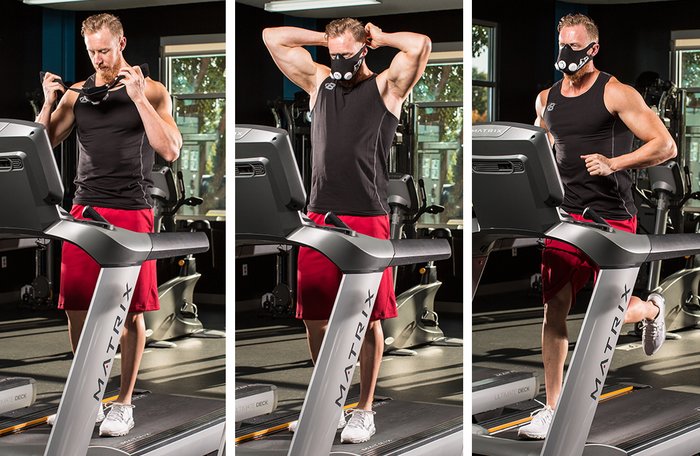
Instead of deep, quality breaths in sync with each portion of the lift (concentric or eccentric), you get short, shallow breaths, which don't do anything for stabilization or control of the weight. You can't perform the Valsalva maneuver correctly, because you can't draw in enough air to sufficiently increase intra-abdominal pressure and stabilize the trunk.
There is absolutely zero scientific evidence suggesting elevation masks will elicit beneficial adaptations with resistance training. Think about it: You will unquestionably reach a higher training intensity and attain greater volume by breathing freely than you would if you had to perform lighter weight and fewer sets due to the mask.
Altitude Masks Final Breaths
If you really want to reap the benefits of high altitude, such as increased red blood cell count, research suggests you'll have to live a pretty sedentary lifestyle at high altitudes, but you may have to train at lower altitudes to see maximum training adaptations.
Because the air is thinner at high altitudes, your body responds by creating more red blood cells to boost oxygen-carrying capabilities levels, even if you're just sitting or sleeping. This increase in oxygen in your blood can help power you through your aerobic workouts, but training at a high altitude will lead to poorer performance and slower times. That's not a problem when training at sea level, which has led to the popular phrase, "Live high, train low."
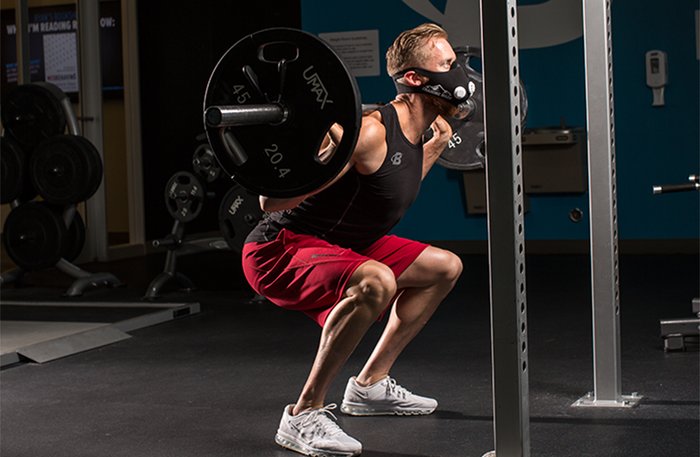
From a physiological perspective, there isn't a shred of research or anecdotal evidence behind the utility of these masks, nor do they in any way simulate the physiology of training at altitude.
However, living at sea level and spending just a few hours in an altitude chamber isn't enough to increase your number of red blood cells. That's why you see some very serious endurance athletes actually sleeping in one of these units. If you're thinking about bringing home the next Olympic gold in the marathon, you'll need to spend about 20-22 hours a day, five days a week, at an elevation above sea level for at least four weeks to see any adaptation. No one said winning was easy!
One final thought: I have heard several supporting statements regarding the psychological aspect of wearing masks during training, especially among MMA fighters who want to simulate what may happen should an opponent try and restrict their breathing. That's a perfectly fair statement—if wearing a mask helps from a psychological perspective, have at it.
But from a physiological perspective, there isn't a shred of research or anecdotal evidence behind the utility of these masks, nor do they in any way simulate the physiology of training at altitude. Your money and training energy are better spent elsewhere.
References
- McKenzie, D. C. (2012). Respiratory physiology: adaptations to high-level exercise. British Journal of Sports Medicine, bjsports-2011.
- Naeije, R. (2010). Physiological adaptation of the cardiovascular system to high altitude. Progress in Cardiovascular Diseases, 52(6), 456-466.
- Vogt, M., & Hoppeler, H. (2010). Is hypoxia training good for muscles and exercise performance? Progress in Cardiovascular Diseases, 52(6), 525-533.
- McGinnis, G., Kliszczewiscz, B., Barberio, M., Ballmann, C., Peters, B., Slivka, D., ... & Quindry, J. (2014). Acute hypoxia and exercise-induced blood oxidative stress. International Journal of Sport Nutrition and Exercise Metabolism, 24, 684-693.
- Buchheit, M., Hammond, K., Bourdon, P. C., Simpson, B. M., Garvican-Lewis, L. A., Schmidt, W. F., ... & Aughey, R. J. (2015). Relative Match Intensities at High Altitude in Highly-Trained Young Soccer Players (ISA3600).Journal of Sports Science & Medicine, 14(1), 98.
- McLean, B. D., Gore, C. J., & Kemp, J. (2014). Application of ‘live low-train high’for enhancing normoxic exercise performance in team sport athletes. Sports Medicine, 44(9), 1275-1287.
- Truijens, M. J., Toussaint, H. M., Dow, J., & Levine, B. D. (2003). Effect of high-intensity hypoxic training on sea-level swimming performances. Journal of Applied Physiology, 94(2), 733-743.
- Berry, M. J., Adair, N. E., Sevensky, K. S., Quinby, A., & Lever, H. M. (1996). Inspiratory muscle training and whole-body reconditioning in chronic obstructive pulmonary disease. American Journal of Respiratory and Critical Care Medicine, 153(6), 1812-1816.
- Langer, D., Charususin, N., Jácome, C., Hoffman, M., McConnell, A., Decramer, M., & Gosselink, R. (2015). Efficacy of a Novel Method for Inspiratory Muscle Training in People With Chronic Obstructive Pulmonary Disease. Physical Therapy.
- Klusiewicz, A., Borkowski, L., Zdanowicz, R., Boros, P., & Wesolowski, S. (2008). The inspiratory muscle training in elite rowers. Journal of Sports Medicine and Physical Fitness, 48(3), 279.
- Williams, J. S., Wongsathikun, J., Boon, S. M., & Acevedo, E. O. (2002). Inspiratory muscle training fails to improve endurance capacity in athletes. Medicine and Science in Sports and Exercise, 34(7), 1194-1198.
- Hanel, B., & Secher, N. H. (1991). Maximal oxygen uptake and work capacity after inspiratory muscle training: a controlled study. Journal of Sports Sciences, 9(1), 43-52.
- Inbar, O., Weiner, P., Azgad, Y., Rotstein, A., & Weinstein, Y. (2000). Specific inspiratory muscle training in well-trained endurance athletes. Medicine and Science in Sports and Exercise, 32(7), 1233-1237.
- Riganas, C. S., Vrabas, I. S., Christoulas, K., & Mandroukas, K. (2008). Specific inspiratory muscle training does not improve performance or VO2max levels in well trained rowers. Journal of Sports Medicine and Physical Fitness, 48(3), 285.
- Levine, B. D. (2002). Intermittent hypoxic training: fact and fancy. High Altitude Medicine & Biology, 3(2), 177-193.

